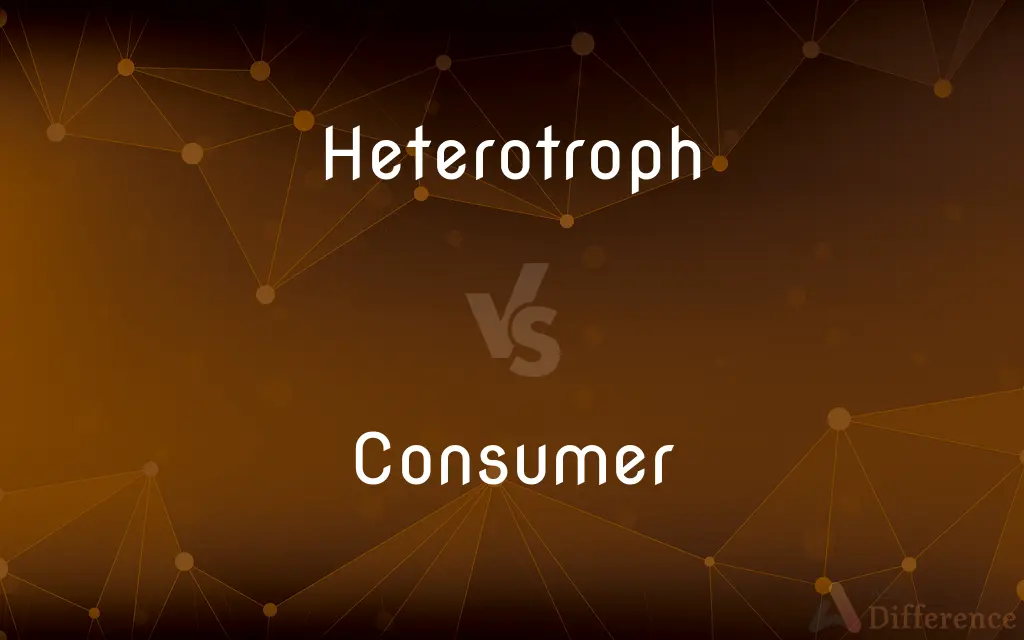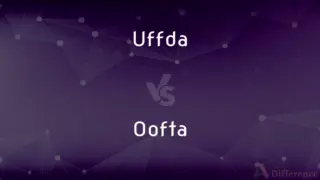Heterotroph vs. Consumer — What's the Difference?
Edited by Tayyaba Rehman — By Urooj Arif — Updated on April 25, 2024
Heterotrophs obtain energy by consuming organic substances, encompassing all consumers in ecosystems, whereas consumers specifically refer to organisms that ingest others within a food web.

Difference Between Heterotroph and Consumer
Table of Contents
ADVERTISEMENT
Key Differences
Heterotrophs depend on organic substances for nourishment, deriving energy by consuming other living or deceased organisms. Consumers, on the other hand, are a specific category within heterotrophs that actively feed on other organisms, directly participating in the transfer of energy through an ecosystem's food chain.
While heterotrophs can be organisms that decompose or absorb nutrients from decaying material (like fungi and bacteria), consumers specifically ingest other organisms, whether they are plants, animals, or decomposed organic material.
Heterotrophs include all organisms not capable of producing their own food, thereby relying on the organic compounds created by other organisms. Consumers focus specifically on this dynamic within trophic levels of ecosystems, highlighting their role in the consumption of biomass.
Heterotrophs are essential for recycling nutrients in ecosystems, breaking down organic material that can then be reused by other organisms. Consumers contribute directly to this cycle by breaking down complex organic compounds into simpler forms that decomposers can further process.
In ecosystems, heterotrophs ensure energy flow from producers to various other trophic levels through various processes including consumption, absorption, and decomposition. Whereas consumers are primarily involved in the consumption process, directly impacting the food chain dynamics by their dietary habits.
ADVERTISEMENT
Comparison Chart
Definition
Organisms that cannot synthesize their own food and rely on other organic substances.
A type of heterotroph that ingests other organisms.
Types
Includes decomposers, parasites, and saprotrophs.
Primarily herbivores, carnivores, and omnivores.
Role in Ecosystem
Decompose, absorb, or consume organic material.
Specifically consume other organisms to obtain energy.
Dependency on Other Life Forms
Depend on both living and non-living organic matter.
Depend directly on living organisms for food.
Example Organisms
Fungi, bacteria, and all animals.
Herbivores like deer, carnivores like lions.
Compare with Definitions
Heterotroph
Organisms that consume other organic substances to survive.
A mushroom growing on a decaying log is a heterotroph.
Consumer
Divided into categories like herbivores, carnivores, and omnivores.
Cows grazing on grass are consumers classified as herbivores.
Heterotroph
Cannot produce their own food through photosynthesis or chemosynthesis.
All animals, from tiny insects to large whales, are heterotrophs.
Consumer
Directly affects the population dynamics of prey species.
Predatory birds control insect populations, showcasing their role as consumers.
Heterotroph
Relies on the organic matter produced by autotrophs.
Fish feed on plant material in the water, illustrating their heterotrophic nature.
Consumer
Specifically ingests other organisms within a food web.
A wolf preying on a deer is an example of a consumer.
Heterotroph
Found across various ecosystems, adapting to diverse food sources.
Bacteria in hydrothermal vents are heterotrophs that consume minerals from the Earth's crust.
Consumer
Essential for energy transfer across different trophic levels.
Bears, which eat fish and berries, transfer energy from both plant and animal sources.
Heterotroph
Includes consumers, decomposers, and more.
A vulture eating carrion is a heterotroph playing a role as a consumer and decomposer.
Consumer
Typically does not include decomposers or detritivores.
Unlike bacteria that break down dead matter, a lion consumes living prey.
Heterotroph
A heterotroph (; from Ancient Greek ἕτερος héteros "other" and τροφή trophḗ "nutrition") is an organism that cannot produce its own food, instead taking nutrition from other sources of organic carbon, mainly plant or animal matter. In the food chain, heterotrophs are primary, secondary and tertiary consumers, but not producers.
Consumer
A consumer is a person or a group who intends to order, orders, or uses purchased goods, products, or services primarily for personal, social, family, household and similar needs, not directly related to entrepreneurial or business activities.
Heterotroph
An organism that is dependent on complex organic substances for nutrition because it cannot synthesize its own food.
Consumer
One that consumes, especially one that acquires goods or services for direct use or ownership rather than for resale or use in production and manufacturing.
Heterotroph
(ecology) An organism which requires an external supply of energy in the form of food as it cannot synthesize its own.
Consumer
(Ecology) A heterotrophic organism that ingests other organisms or organic matter in a food chain.
Heterotroph
An organism that depends on complex organic substances for nutrition
Consumer
One who, or that which, consumes.
Consumer
(economics) Someone who trades money for goods or services as an individual.
This new system favours the consumer over the producer.
Consumer
(by extension) The consumer base of a product, service or business.
Our consumers are upwardly mobile and middle-class.
Consumer
(ecology) An organism (heterotroph) that uses other organisms for food in order to gain energy.
Consumer
One who, or that which, consumes; as, the consumer of food.
Consumer
The person or organization that uses some item of commerce or service in its own acitities, as opposed to reselling the item or including it as part of another item for resale; - called also the end user.
Consumer
A person who uses goods or services
Common Curiosities
What defines a heterotroph?
A heterotroph is an organism that cannot synthesize its own food and must consume other organic substances for energy.
What is an example of a consumer?
A lion, which eats other animals, is a classic example of a consumer.
Can a consumer be a producer?
No, consumers are solely heterotrophs and do not have the capability to produce their own food through photosynthesis.
Are all animals heterotrophs?
Yes, all animals are heterotrophs as they cannot produce their own food and rely on other sources of organic material.
What role do consumers play in the ecosystem?
Consumers help maintain population control of other species and facilitate energy transfer through food chains.
Why are heterotrophs not capable of photosynthesis?
Heterotrophs lack the chlorophyll and other necessary structures for photosynthesis, which autotrophs possess.
Are humans considered consumers?
Yes, humans are consumers as they eat plants and animals but cannot synthesize their own food.
What is the importance of heterotrophs in nature?
Heterotrophs are crucial for nutrient cycling and maintaining ecological balance by consuming organic matter.
Is a shark a consumer or a heterotroph?
A shark is both a consumer and a heterotroph, as it eats other marine organisms but cannot produce its own food.
How does a consumer differ from other types of heterotrophs?
Consumers specifically ingest other organisms, unlike decomposers or absorbers that derive nutrients from non-living organic material.
Do all consumers need to eat meat?
No, consumers include herbivores who eat only plants, carnivores who eat meat, and omnivores who eat both.
Can a heterotroph also be a decomposer?
Yes, some heterotrophs, like certain fungi and bacteria, act as decomposers, breaking down dead organic matter.
What distinguishes a consumer from a parasite?
While both are consumers, parasites specifically feed on their host without necessarily killing them, often resulting in mutual or detrimental effects.
What is the main source of energy for a heterotroph?
The main source of energy for heterotrophs is the organic material produced by autotrophs or other heterotrophs.
How do consumers affect biodiversity?
Consumers affect biodiversity by controlling the population levels of other organisms, thus maintaining ecosystem stability.
Share Your Discovery

Previous Comparison
Uffda vs. Oofta
Next Comparison
Shower vs. BathAuthor Spotlight
Written by
Urooj ArifUrooj is a skilled content writer at Ask Difference, known for her exceptional ability to simplify complex topics into engaging and informative content. With a passion for research and a flair for clear, concise writing, she consistently delivers articles that resonate with our diverse audience.
Edited by
Tayyaba RehmanTayyaba Rehman is a distinguished writer, currently serving as a primary contributor to askdifference.com. As a researcher in semantics and etymology, Tayyaba's passion for the complexity of languages and their distinctions has found a perfect home on the platform. Tayyaba delves into the intricacies of language, distinguishing between commonly confused words and phrases, thereby providing clarity for readers worldwide.














































